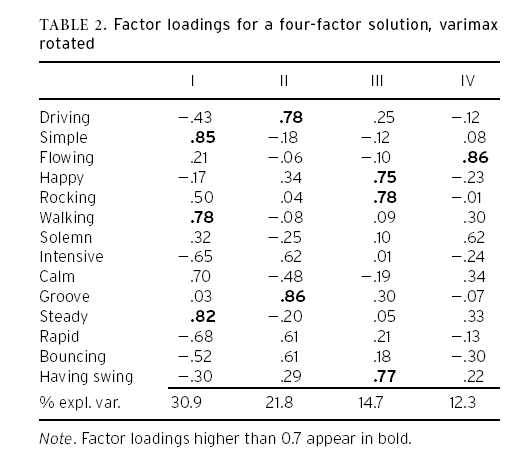The following factor analyses (principal
component extraction, varimax normalized factor rotation) were
therefore based on means across participants, supported by the
robust results reported above. A two- factor solution could be
interpreted as tension–relaxation
and groove (with 67.7% total explained
variance), a three- factor solution addedflow
with the eigenvalue 1.72 and 74.7% total explained variance. A
four-factor solution increased the explained variance to
79.8%, with the addition of a factor with high positive loadings
for Happy, Rocking, and Having swing. Although the
eigenvalue for the fourth factor initially was only 0.72 (5.14%),
its explained variance increased to 14.8% by the factor rotation.
The explained variance that can be attributed to groove was 25.5%
for the two-factor solution, 25.5% for three factors, and 21.8% for
the fourfactor solution, which also featured a dimension for Having
swing. The factor loading matrix for this solution is shown in
Table 2.

Table 2 can be interpreted as follows. Factor
I seems to reflect rhythmical simplicity and the movement quality
of walking. One could speculate that this correspond with
uniform accentuation of regularly occurring events with intervals
close to those characteristic for human gait. It might represent
the commonly found simple–complex dimension, which covaries
with the rhythmic simplicity associated with Walking,Calm, and
Steady, and has negative loadings for the rhythmic complexity
associated with Driving, Intensive, Bouncing, Rapid, and Having
swing. Thus regular–irregular might be more fitting than
simple–complex, for example.
Factor II has its highest loading for
Groove and goes together with Driving, Intensive, and to some
extent with Rapid and Bouncing. Both Driving and Intensive seem to
reflect movement induction. This is not obviously the case for
Rapid, however, but in a natural sample it is conceivable that
music intended to be less Driving and Intensive is also slower. It
is thus likely that Rapid is involved in spurious correlations as a
result of dependencies inherent in the sample.
Factor III has high loadings for Happy,
Rocking, and Having swing. It probably assumes the commonly found
dimension happy–sad, which tends to covary with Rapid and
Having swing because the swing music examples tend to be fast, and
a high tempo is associated with happiness (Juslin & Laukka,
2003).
Factor IV is mainly associated with Flowing, but
to some extent also with Solemn, Calm, and Steady. In previous
research Flowing is rarely included, whereas Solemn is a commonly
found factor. It is therefore difficult to interpret this factor.
It might be the case that Flowing is a unique dimension for music
experience, although this has not yet been established.
Alternatively, the nature of the present music sample or the rating
scales’ focus on rhythm might have emphasized this dimension
in the minds of the listeners. Future research should include
flowing in order to explore its nature and apparent correlation
with Solemn.

